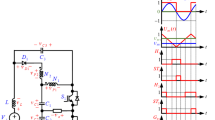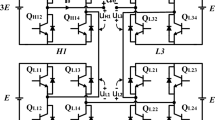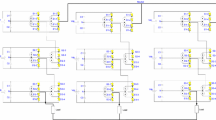Abstract
In view of the fact that the number of units required for the symmetric quasi-Z source cascaded H-bridge increases rapidly with the increase of the number of output levels and the switching frequency of the quasi-Z source inverter is multiplied during the insertion of the shoot-through signal of the traditional modulation method, a novel hybrid quasi-Z-source inverter topology and a modulation strategy are proposed. The topology consists of a quasi-Z-source cascaded H-bridge inverter (low-voltage unit) and a traditional H-bridge inverter (high-voltage unit). For the modulation strategy, the improved trapezoidal wave (ITPWM) is adopted as the modulation wave of the high-voltage unit (working at the fundamental frequency), and the step-wave method is utilized for modulation; for the low-voltage unit, the multi-modulation wave phase-shift modulation method is used for modulation, and the modulation wave of the low-voltage unit is shifted up and down, and the shoot-through signal is implanted into the switching moment of the inverter switch. Simulation and experimental results show that by the new topology and modulation strategy proposed in this paper, the number of quasi-Z sources cascaded H-bridge units can be significantly reduced, the switching losses can be greatly reduced, and the utilization rate of DC voltage can be increased. The maximum efficiency can reach 95.92%. Compared with the traditional modulation strategy, the efficiency is increased by 1.83%, and the DC voltage utilization rate is increased by 19.19%.














Similar content being viewed by others
References
Kun X, Zhu L, Zeng Y et al (2015) Rese-arches on the method of suppressing commutation torque ripple for brushless DC motors based on a quasi-Z-source net. Proc CSEE 35(4):971–978
Komurcugil H, Bayhan S, Bagheri F, Kukrer O, Abu-Rub H (2018) Model-b0ased current control for single-phase grid-tied quasi-Z-source inverters with virtual time constant. IEEE Trans Ind Electron 65(10):8277–8286
Liu J, Wu J, Qiu J, Zeng J (2019) Switched Z-source/quasi-Z-source DC–DC converters with reduced passive components for photovoltaic systems. IEEE Access 7:40893–40903
Li Y, Jiang S, Cintron-Rivera JG et al (2013) Modeling and control of quasi-Z-source inverter for distributed generation applications. IEEE Trans Ind Electron 60(4):1532–1541
Liu Y, Ge B, Abu-Rub H (2013) Modelling and controller design of quasi-Z-source cascaded multilevel inverter-based three-phase grid-tie photovoltaic power system. IET Renew Power Gener 8(8):925–936
Liu Y, Ge B, Abu-Rub H et al (2014) An effective control method for three-phase quasi-Z-source cascaded multi-level inverter bases grid-tie photovoltaic power system. IEEE Trans Ind Electron 61(12):6794–6802
Liu Y, Ge B, Abu-Rub H et al (2014) An effective control method for quasi-Z-source cascade multilevel inverter bases grid-tie single-phase photovoltaic power system. IEEE Trans Ind Inform 10(1):399–407
Liang W, Liu Y, Peng J (2020) A day and night operational quasi-Z-source multilevel grid-tied pv power system to achieve active and reactive power control. IEEE Trans Power Electron 36(1):474–492
Sun D, Ge B, Yan X et al (2014) Modeling impedance design and efficiency analysis of quasi-Z-source module in cascaded multilevel photovoltaic power system. IEEE Trans Ind Electron 61(11):6108–6117
Liu Y, Ge B, Li X, Xue Y (2019) Common mode voltage reduction of single-phase quasi-Z-source inverter Bases photovoltaic system. IEEE Access 7:154572–154580
Ho A, Chun T (2017) Single-phase modified quasi-Z-source cascaded hybrid five-level inverter. IEEE Trans Ind Electron 65(6):5125–5134
Liang W, Liu Y, Ge B, Wang X (2018) DC-link voltage balance control strategy based on multidimensional modulation technique for quasi-Z-source cascaded multilevel inverter photovoltaic power system. IEEE Trans Ind Inform 14(11):4905–4915
Mohammadi M, Moghani JS, Milimonfared J (2018) A novel dual switching frequency modulation for Z-source and quasi-Z-source inverters. IEEE Trans Ind Electron 65(6):5167–5176
Dongsen S, Baoming Ge, Xingyu Y et al (2015) modeling impedance design and efficiency analysis of quasi-Z source module in cascaded multilevel photovoltaic power system. IEEE Trans Ind Electron 61(11):6108–6117
Weihua L, Yushan L, Baoming Ge et al (2017) Double-line-frequency ripple model analysis and impedance design for energy stored single-phase quasi-Z source photovoltaic system. IEEE Trans Ind Electron 65(4):3198–3209
Yan Z, Liming L, Hui Li (2013) A high-performance photovoltaic module-integrated converter (MIC) based on cascaded quasi-Z-source inverters (qZSI) using eGaN FETs. IEEE Trans Power Electron 28(6):2727–2738
Yushan L, Baoming Ge, Abu-Rub H et al (2014) Overview of space vector modulations for three-phase-source/quasi-Z-source inverters. IEEE Trans Power Electron 29(4):2098–2108
Aiwen Q, Daolian C, Qian S (2018) Simple boost modified space vector modulation strategy for three-phase quasi-Z-source grid-connected inverter. Trans China Electrotech Soc 33(4):826–836
He Y, Xu Y, Chen J (2019) Improved space vector modulation of the quasi-Z-source inverter to suppress DC-link voltage sag. IEEE Access 7:66689–66702
Rahul JR, Annamalai K (2019) FGPA based implementation of single-phase seven-level quasi Z-source inverter. Int J Circuit Theory Appl 47:1970–1989
Nguyen MK, Lim YC, Park SJ (2015) A comparison between single-phase quasi-Z-source and quasi-switched boost inverters. IEEE Trans Ind Electron 62(10):6336–6344
Liu Y, Abu-Rub H, Ge B, Blaabjerg F, Ellabban O, Loh PC (2016) Design of Z-source and quasi-Z-source inverters. In: Liu Y et al (eds) Impedance source power electronic converters. Wiley, Chichester, pp 226–243
Sun D et al (2014) Modeling, impedance design, and efficiency analysis of quasi-Z source module in cascaded multilevel photovoltaic power system. IEEE Trans Ind Electron 61(11):6108–6117
Acknowledgements
This work was supported by the National Natural Science Foundation of China under Grant 61561007, and in part by the Natural Science Foundation of Guangxi Province, China, under Grant 2017GXNSFAA198168.
Author information
Authors and Affiliations
Corresponding author
Additional information
Publisher's Note
Springer Nature remains neutral with regard to jurisdictional claims in published maps and institutional affiliations.
Rights and permissions
Springer Nature or its licensor (e.g. a society or other partner) holds exclusive rights to this article under a publishing agreement with the author(s) or other rightsholder(s); author self-archiving of the accepted manuscript version of this article is solely governed by the terms of such publishing agreement and applicable law.
About this article
Cite this article
Gong, R., Zhan, G., Zhang, X. et al. A novel hybrid quasi-Z-source inverter topology and its modulation strategy. Electr Eng 105, 1067–1077 (2023). https://doi.org/10.1007/s00202-022-01715-0
Received:
Accepted:
Published:
Issue Date:
DOI: https://doi.org/10.1007/s00202-022-01715-0




